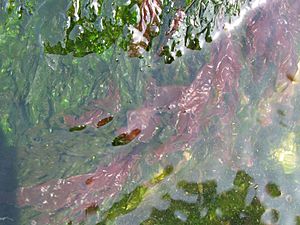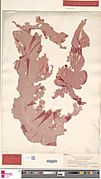Pyropia facts for kids
Quick facts for kids Pyropia |
|
|---|---|
 |
|
| Pyropia yezoensis | |
| Scientific classification |
|
| (unranked): | Archaeplastida |
| Division: | Rhodophyta |
| Class: | Bangiophyceae |
| Order: | Bangiales |
| Family: | Bangiaceae |
| Genus: | Pyropia J.Agardh 1899 |
| Type species | |
| Pyropia californica J.Agardh
|
|
| Species | |
|
See text |
|
Pyropia is a type of red algae, which is a fancy name for a kind of seaweed. You can find it all over the world. It usually grows in areas where the ocean meets the land, called intertidal zones, or in shallow water. Pyropia has special leaf-like parts that can be red, brown, or green. Some types of Pyropia are used to make nori, which is a popular edible seaweed. This makes Pyropia very important for aquaculture, which is like farming in the water.
Contents
What is Pyropia?
Pyropia was first named by a botanist (plant scientist) named Jacob Georg Agardh in 1899. He was a professor at Lund University. For a long time, and sometimes even now, many Pyropia species were thought to be part of a different seaweed group called Porphyra. Scientists are still discovering new types of Pyropia. For example, in 2013, research in New Zealand helped move a species called Pyropia plicata from Porphyra to Pyropia.
How Pyropia Looks
Pyropia species are red seaweeds. They have a round, disc-shaped part called a holdfast that helps them stick to rocks. They also have a short stem, or stipe. Their main parts are thin, folded blades that look like leaves. These blades can be red, brown, or dark green. When unfolded, these blades can be quite large. Some types can grow up to one meter (about 3 feet) long! But most are usually around 20 centimeters (about 8 inches) wide.
Where Pyropia Grows
Pyropia grows in intertidal zones, which are the areas along the coast that are covered by water at high tide and exposed to air at low tide. It can also grow in water up to 10 meters (about 33 feet) deep. This depends on how clear the water is and what the bottom is made of. Pyropia often grows in big patches, sticking to stones and shells. It can cover large areas of the ocean floor. You can find Pyropia all around the world in both warm and cool waters.
How Pyropia Survives
Pyropia species that live in the upper intertidal zone face many challenges. They have to deal with strong sunlight, big changes in temperature, and changes in how salty the water is. They also have to survive when they are out of the water and start to dry out.
Pyropia is especially good at handling heat. Some types can even pause their normal body processes, like photosynthesis, to save energy when it gets too hot. Other types make more fats (lipids) to help them stay moist and not dry out. Because Pyropia is so good at adapting to these tough conditions, scientists study it a lot.
However, Pyropia can get sick. One threat is a type of fungus called Alternaria sp. ZL-1. This fungus has been seen in Pyropia yezoensis farms. It kills Pyropia cells and leaves brown, rust-like spots on the seaweed's blades.
How People Use Pyropia
Many types of Pyropia are used to make nori, which is a popular edible seaweed. The most common types used are Pyropia yezoensis and P. haitanensis. Making nori is a huge business, worth billions of dollars! Most of the world's nori comes from countries like China, Korea, and Japan.
Nori is also known to have a lot of Vitamin B12. However, some health organizations, like the Academy of Nutrition and Dietetics, say that nori might not be a reliable source of Vitamin B12 for people who are vegan. Vegans do not eat any animal products.
Gallery
See also
 In Spanish: Pyropia para niños
In Spanish: Pyropia para niños




